Bring the Filipino bakery experience home with pillowy-soft pandesal—the beloved breakfast roll that’s worth waking up for.
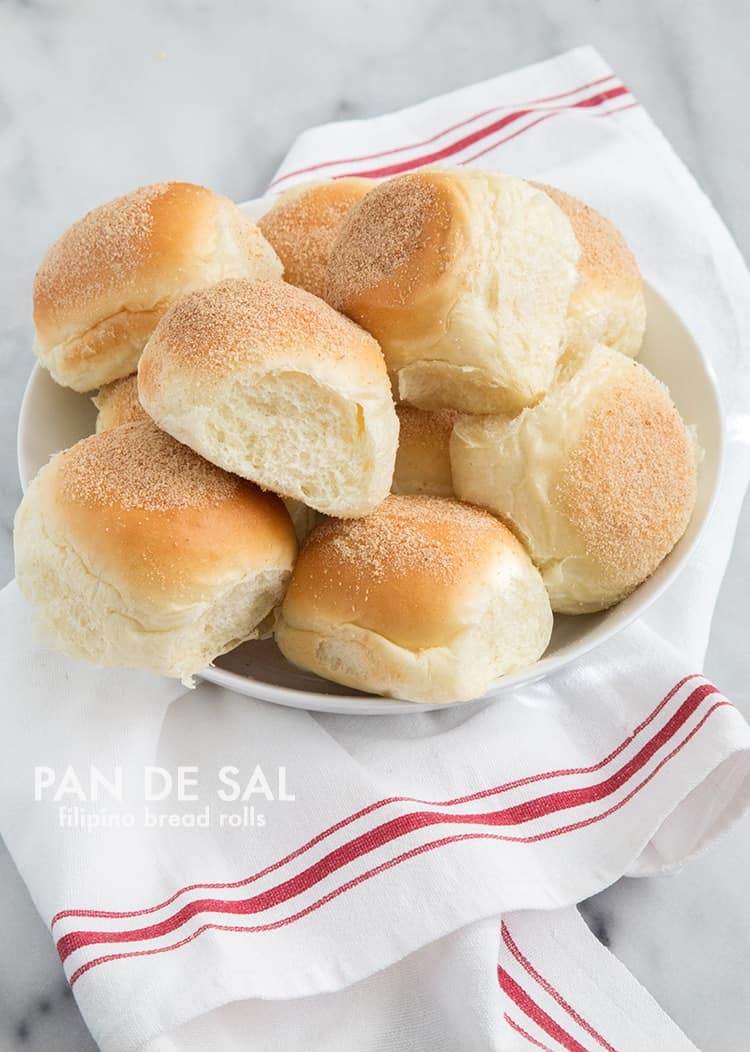
If you’ve ever wandered past a Filipino bakery at dawn, you know the smell: warm, yeasty, slightly sweet pandesal fresh from the oven. These cloud-like bread rolls are the Philippines’ answer to French croissants or San Francisco sourdough—the bread that defines home.
With my professional pastry training and Filipino roots, I’m sharing the technique that creates that signature pillowy crumb and golden breadcrumb coating. Whether you’re reconnecting with childhood memories or discovering pandesal for the first time, this recipe delivers authentic results.
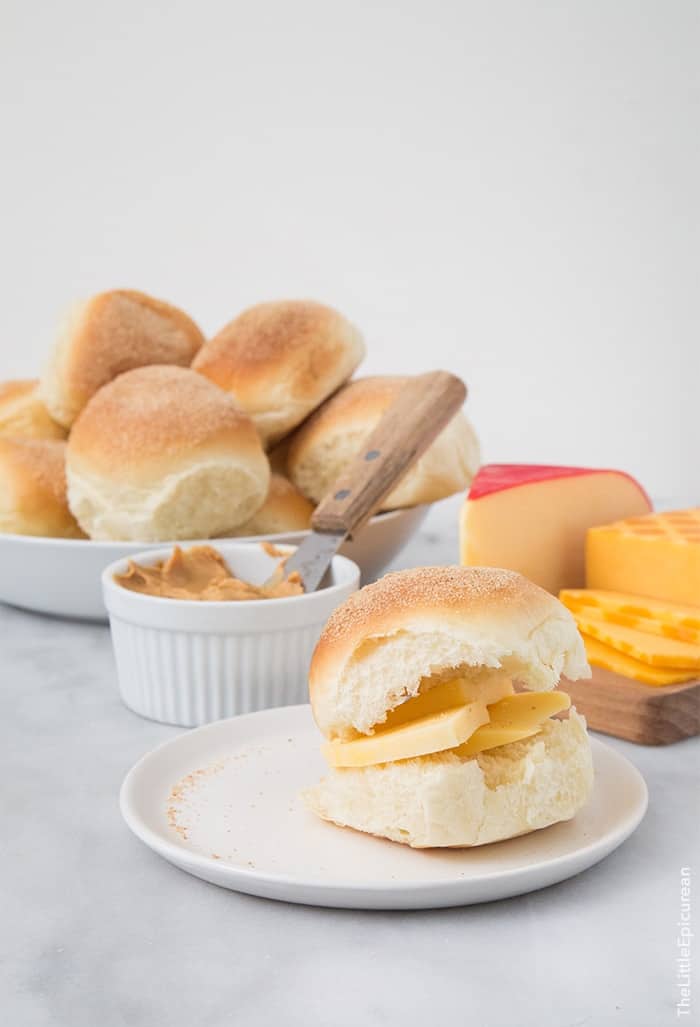
What is Pandesal?
Pandesal (also spelled pan de sal) is the quintessential breakfast bread of the Philippines. These slightly sweet, pillowy-soft rolls are instantly recognizable by their breadcrumb coating and oval shape. Unlike dinner rolls that accompany meals, pandesal is the star of Filipino breakfast and merienda (afternoon snack).
The texture sits somewhere between Hawaiian sweet rolls and classic dinner rolls—tender and fluffy with a delicate crumb, but much less sweet than Hawaiian rolls. Fresh from the oven, they’re best enjoyed warm, torn open to release their soft, steamy interior.
The Story Behind the Bread
In the Philippines, pandesal isn’t just breakfast—it’s a daily ritual. Before sunrise, Filipinos line up at neighborhood bakeries to buy pandesal “mainit-init” (piping hot), often still warm enough that the paper bag becomes translucent with steam.
The name “pan de sal” literally translates to “salt bread” in Spanish, a remnant of Spanish colonial influence. Ironically, modern pandesal is slightly sweet rather than salty, though the name stuck. This bread evolved from Spanish pan de agua, adapting to Filipino tastes and local ingredients over generations.
Today, every region has slight variations—some softer, some denser, some sweeter—but all share that distinctive breadcrumb coating. Try the popular ube cheese pandesal variation!
What makes pandesal special isn’t just the recipe; it’s the memories attached to it. It’s coffee dipped with your lola (grandmother) or cheese sandwiches packed for school. That’s what I want to help you recreate in your own kitchen.
Essentials Tools
While you can make pandesal with minimal equipment, these tools make the process easier and more consistent:
- Kitchen Scale: Professional bakers work by weight, not volume. A digital scale ensures every roll is the same size, so they bake evenly. This is the single most important tool for consistent results.
- Stand Mixer with Dough Hook: Makes kneading effortless, though hand kneading absolutely works—it just takes longer and builds arm muscles.
- Instant-Read Thermometer: Takes the guesswork out of milk temperature. Yeast is finicky about temperature, and this $15 tool saves batches from failure.
- 18×13-inch Half Sheet Pan: Professional bakers use half sheets for even heat distribution. The size matters—too small and rolls crowd each other; too large and they spread too thin.
- Bench Scraper: Invaluable for portioning dough cleanly and scraping your work surface. So many variations to choose from.
- Plastic Wrap: Keeps dough from forming that dreaded “elephant skin” during rising.
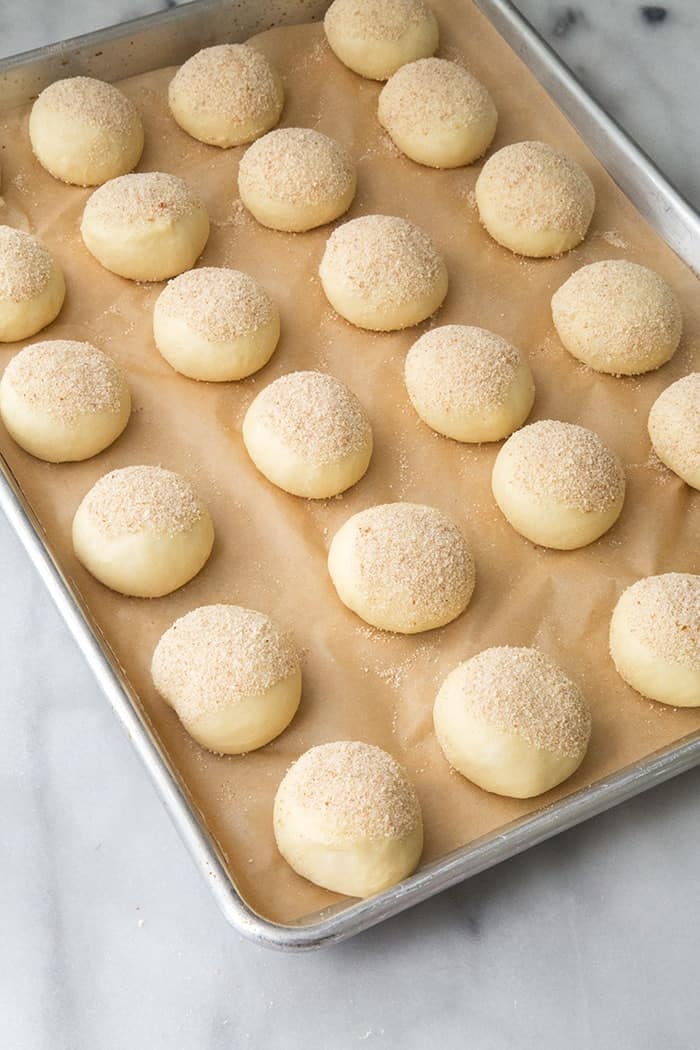
Pandesal Ingredients
These bread rolls rely on simple, pantry-friendly ingredients. Here’s what you’ll need:
- Dry Ingredients
- 3 cups (390g) all-purpose flour
- 1½ cups (195g) bread flour
- 1½ teaspoons kosher salt (Diamond Crystal)
- Wet Ingredients
- 2¼ teaspoons active dry yeast
- 1¼ cups (285g) whole milk, warmed to 100-105°F
- ⅓ cup (70g) granulated sugar
- 3 tablespoons (43g) unsalted butter, room temperature
- 2 large eggs, room temperature, lightly whisked
- For Coating
- Fine breadcrumbs, as needed (about 1 cup)
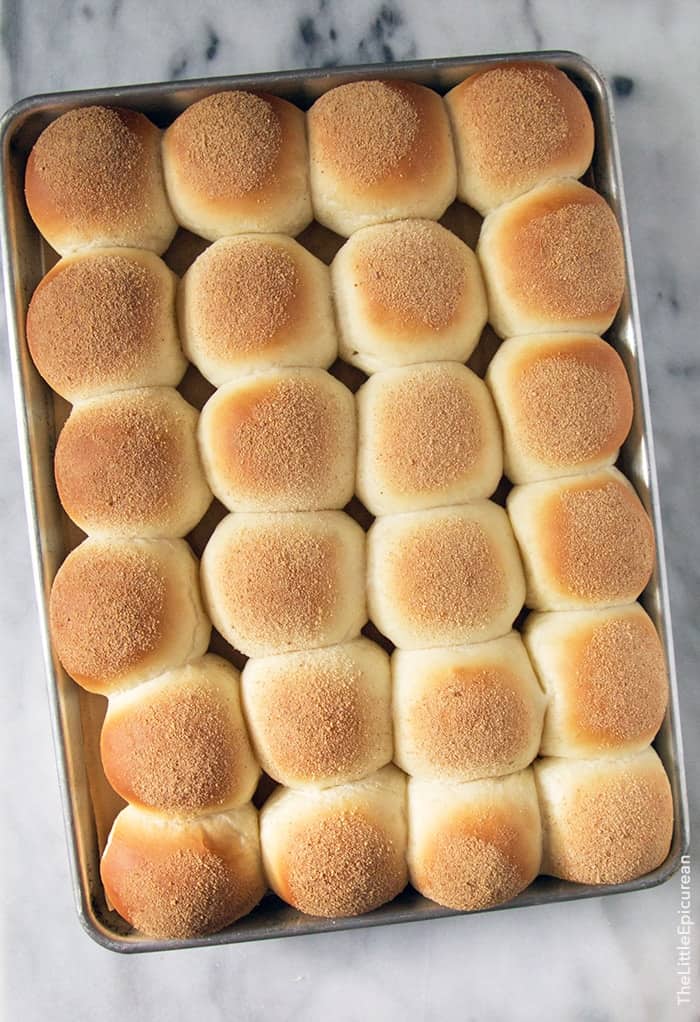
Step-by-Step Instructions
Activating the Yeast: The Foundation
- Warm the milk to 100-105°F. Pour into the bowl of your stand mixer. Sprinkle the yeast over the milk and add 2 teaspoons of the sugar. Stir gently to combine.
- Let stand for 5-10 minutes until the mixture becomes foamy and fragrant, smelling slightly like beer. This tells you the yeast is alive and active. If nothing happens, your yeast is dead—start over with fresh yeast.
Building the Dough: Proper Mixing Technique
- In a separate large bowl, whisk together the all-purpose flour, bread flour, and salt. Set aside.
- Add the remaining sugar, room temperature butter, and lightly whisked eggs to the yeast mixture in the stand mixer.
- Fit the mixer with the dough hook attachment. With the mixer running on low speed, add the flour mixture in three additions, allowing each to incorporate before adding the next. Scrape down the sides of the bowl as needed.
- Once all flour is added, increase speed to medium. Knead for 5-7 minutes until the dough comes together into a smooth, elastic ball. The dough should pull away from the sides of the bowl and feel soft and supple, though slightly tacky. Don’t add more flour—this tackiness is what creates tender rolls.
First Rise: Patience Pays Off
- Lightly oil a large bowl. Remove dough from the mixer and shape into a ball. Place in the oiled bowl, turning once to coat all sides. Cover tightly with plastic wrap.
- Let rise at room temperature (72-75°F is ideal) for about 1 hour, until doubled in volume. The dough should look puffy and hold an indentation when gently pressed with a finger.
Shaping and Coating: The Signature Look
- Punch down the dough to release air bubbles. Turn out onto a clean work surface. Using your bench scraper or a knife, divide the dough into 24 equal portions. For precision, weigh the entire dough mass, divide by 24, and portion by weight (each piece should be about 35-40g).
- Roll each portion into a smooth ball by cupping your hand over the dough and moving it in circles on the work surface. The dough should roll against the counter, creating surface tension that forms a smooth top.
- Pour breadcrumbs into a shallow bowl. Dip the top of each dough ball into the breadcrumbs, coating generously. Place breadcrumb-side up on a parchment-lined 18×13-inch baking sheet, spacing them about 1½ inches apart.
- Cover the entire pan loosely with plastic wrap to prevent the dough from drying out. This is crucial—exposed dough forms a skin that prevents proper rising and breadcrumb adhesion.
Final Proof and Baking: Achieving Golden Perfection
- Let the rolls proof at room temperature for 20-30 minutes, until noticeably puffy and nearly doubled in size. They should look pillowy and soft, with visible expansion.
- Meanwhile, preheat your oven to 350°F.
- Remove the plastic wrap. Bake for 20-25 minutes, until the rolls are golden brown and fragrant. The breadcrumb coating should be toasted and crispy, and the rolls should sound hollow when tapped on the bottom.
- Transfer to a wire rack. Serve warm or at room temperature. Try your hardest not to eat them all in one sitting—I know it’s difficult!
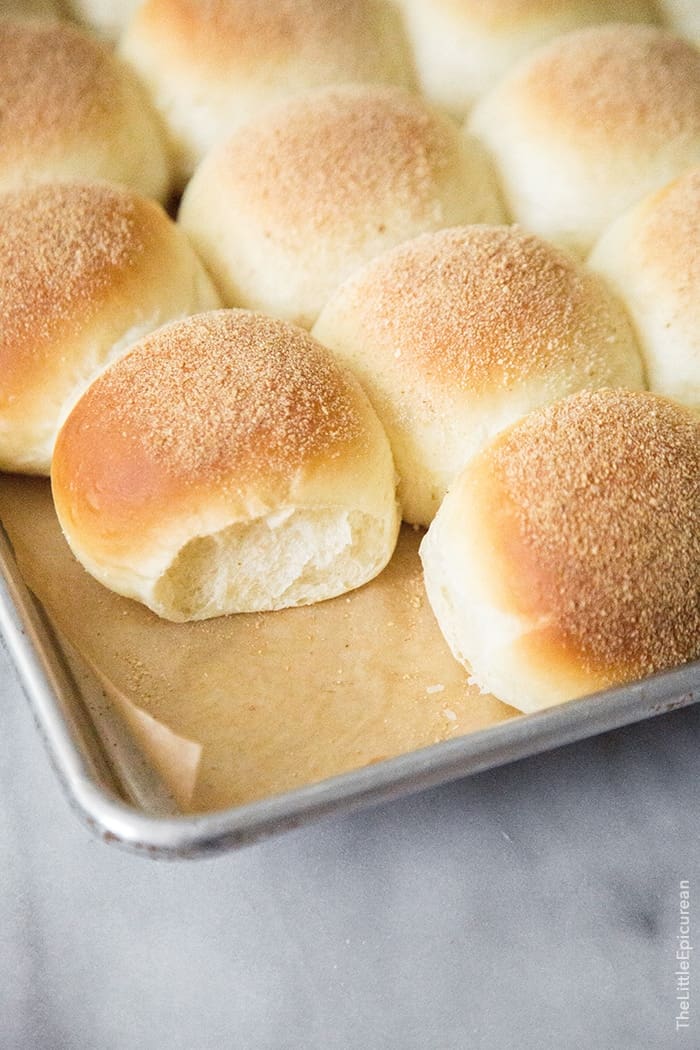
How to Serve Pandesal Filipino-Style
Part of pandesal’s charm is its versatility. Here’s how Filipinos enjoy these rolls throughout the day:
Traditional Morning Pairings:
- With kesong puti (fresh Filipino white cheese) or sharp cheddar
- Dipped in hot coffee or Filipino hot chocolate (tsokolate)
- Stuffed with scrambled eggs and dried fish
- Spread with liver pâté or corned beef
Sweet Options:
- Peanut butter
- Sweetened condensed milk drizzled inside
- Butter and sugar (the childhood favorite)
- Ube halaya (purple yam jam)
- Coconut jam (matamis na bao)
The Filipino “Sawsaw” Tradition: Filipinos love to “sawsaw” (dip) pandesal. Tear the roll open while hot, releasing steam, then dunk it in your coffee until just soaked. The combination of slightly sweet bread with bitter coffee is perfection. You can also try dipping in hot chocolate or even condensed milk for extra indulgence.
Pandesal Sandwiches:
- Ham and cheese (the classic packed lunch)
- Tuna salad or egg salad
- Pulled pork with pickled vegetables
Storage and Make-Ahead
Room Temperature Storage: Keep completely cooled pandesal in an airtight container for up to 3 days. They’re best enjoyed within 24 hours for optimal freshness.
Refrigerating Dough (Professional Method): After the first rise (step 8), you can refrigerate the dough overnight instead of shaping immediately. Punch down, cover tightly, and refrigerate for up to 24 hours. The next morning, let it come to room temperature (about 30 minutes), then proceed with shaping and the final proof. This slow fermentation actually develops more flavor.
Freezing Baked Pandesal: Freeze completely cooled rolls in freezer bags for up to 2 months. Thaw at room temperature, then reheat in a 300°F oven for 5-7 minutes to crisp up the exterior.
Best Reheating Method: For that fresh-baked texture, wrap rolls in a damp paper towel and microwave for 10-15 seconds, or reheat in a 300°F oven for 5 minutes. The steam from the damp towel or oven heat softens them beautifully.
Frequently Asked Questions
Absolutely! Hand kneading works perfectly—it just takes longer (about 10-12 minutes of active kneading). The dough is ready when it’s smooth, elastic, and passes the windowpane test. Hand kneading also gives you a better feel for the dough’s texture, which many bakers prefer.
For best results, use the AP flour and bread flour combination as written. If you don’t have bread flour, you can substitute with all-purpose flour for the entire recipe—you’ll still get delicious rolls, just slightly less chewy.
Do NOT use whole wheat flour without adjusting the liquid, and never use self-rising flour, which contains baking powder and salt.
Yes, though milk provides richer flavor and creates a softer crust. If substituting water, the rolls will be slightly less tender. You can also use low-fat milk, or in a pinch, mix ½ cup evaporated milk with ¾ cup water.
I exclusively use Diamond Crystal Kosher Salt in all my recipes for consistency. It’s less salty than Morton’s kosher salt, table salt, or fine sea salt. If using a different salt, reduce the amount slightly and add more to taste if needed.
After kneading, the dough should be smooth, elastic, and slightly tacky but not sticky. Perform the windowpane test: pinch off a small piece and stretch it gently between your fingers. If it forms a thin, translucent membrane without tearing, your gluten is properly developed.
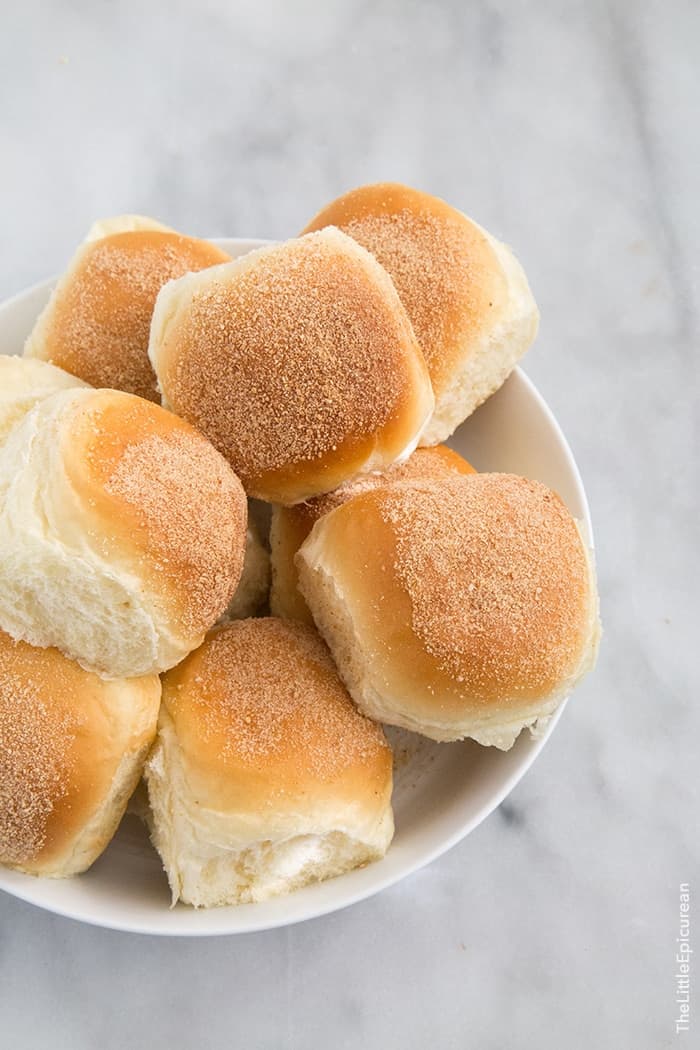
Troubleshooting Guide
This almost always comes down to dead yeast. When you mix yeast with warm milk and sugar, it should smell fragrant (like beer) and foam up within 5 minutes. If nothing happens, the yeast is no longer active—check the expiration date and try the yeast freshness test.
Also, cold environments slow rising significantly. If your kitchen is cold, give the dough extra time or find a warmer spot (like inside a turned-off oven with the light on).
This happens when the dough surface dries out and forms an “elephant skin.” Keep the dough covered with plastic wrap at all times during portioning, resting, and proofing. If the surface feels dry, lightly mist it with water before dipping in breadcrumbs.
The two most common culprits:
Overworked dough: Too much mixing or handling overdevelops gluten, making the dough tight and elastic. Overworked dough needs more resting time to relax. Mix just until the dough is smooth and passes the windowpane test.
Improper proofing: Overproofed dough rises too much and then collapses, baking up dense because it has no energy left to rise in the oven. Underproofed dough hasn’t had enough time to develop air pockets, also resulting in dense bread. Proof by sight and touch, not just by time.
Don’t stress about bread making—it’s actually quite relaxing once you get the rhythm. Whenever I’m stressed or need to clear my mind, I bake a batch of bread. Maybe it’s learning patience through the rising process, or the repetitive motion of shaping dough, but more likely it’s the incredible aroma of fresh bread filling my kitchen. That scent alone makes everything better.
A kitchen filled with the smell of pandesal is pretty hard to beat. And sharing these warm rolls with family? Even better.
Pandesal (Filipino Bread Rolls)
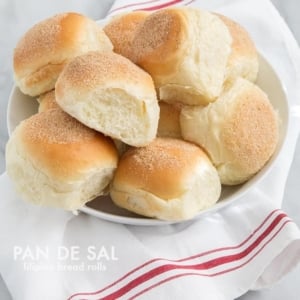
Ingredients
- 2 ¼ teaspoon active dry yeast
- 1 ¼ cup (285 g) whole milk, warmed to 100-105℉
- 3 cups (390 g) all-purpose flour
- 1 ½ cups (195 g) bread flour
- 1 ½ teaspoon kosher salt, (Diamond Crystal kosher salt)
- 3 Tablespoons (43 g) unsalted butter, room temp
- ⅓ cup (70 g) granulated sugar
- 2 large large eggs, room temp, lightly whisked
- breadcrumbs, as needed
Instructions
- Activate the yeast: Warm milk to 100-105°F and pour into the bowl of a stand mixer. Sprinkle yeast over the milk and add 2 teaspoons of the sugar. Stir gently and let stand for 5-10 minutes until foamy and fragrant.
- Prepare dry ingredients: In a large bowl, whisk together all-purpose flour, bread flour, and salt. Set aside.
- Combine wet ingredients: Add remaining sugar, butter, and lightly whisked eggs to the yeast mixture in the stand mixer.
- Mix the dough: Fit mixer with dough hook attachment. With mixer on low speed, add flour mixture in three additions, allowing each to incorporate before adding the next. Once all flour is added, increase to medium speed. Knead for 5-7 minutes until dough forms a smooth, elastic ball that pulls away from the bowl sides.
- First rise: Transfer dough to a lightly oiled bowl, turning once to coat. Cover tightly with plastic wrap. Let rise at room temperature for about 1 hour, until doubled in volume.
- Shape the rolls: Punch down dough and turn out onto a clean surface. Divide into 24 equal portions (weigh for precision—each piece should be 35-40g). Roll each portion into a smooth ball.
- Coat with breadcrumbs: Pour breadcrumbs into a shallow bowl. Dip the top of each dough ball into breadcrumbs, coating generously. Place breadcrumb-side up on a parchment-lined 18×13-inch baking sheet, spacing 1½ inches apart. Cover loosely with plastic wrap.
- Final proof: Let rolls proof at room temperature for 20-30 minutes, until puffy and nearly doubled in size.
- Bake: Preheat oven to 350°F. Remove plastic wrap and bake for 20-25 minutes, until golden brown and fragrant. Transfer to a wire rack. Serve warm or at room temperature.All images and text ©The Little Epicurean.
Notes
Dough Tips:
- Proofing times are based on 72°F room temperature. Cold kitchens need longer rising time.
- Keep dough covered with plastic wrap at all times to prevent drying.
- Dough may feel slightly sticky or tacky after kneading—don’t add more flour or the rolls will be dense.
- For best results, weigh ingredients with a kitchen scale.
- If you don’t have bread flour, substitute with all-purpose flour.
- Serve warm or at room temperature
- Delicious with salty cheeses like gouda, edam, or smoked cheddar
- Classic pairings: peanut butter, sweetened condensed milk, or salted butter
- Perfect with Filipino hot chocolate (tsokolate)
Storage and Leftovers:
- Room temperature: 3 days in an airtight container (best within 24 hours)
- Refrigerate unbaked dough: Up to 24 hours after first rise
- Freeze baked rolls: Up to 2 months (reheat before serving)
Nutrition
Nutrition information is automatically calculated, so should only be used as an approximation.
 Like this recipe? Rate & comment below!
Like this recipe? Rate & comment below!
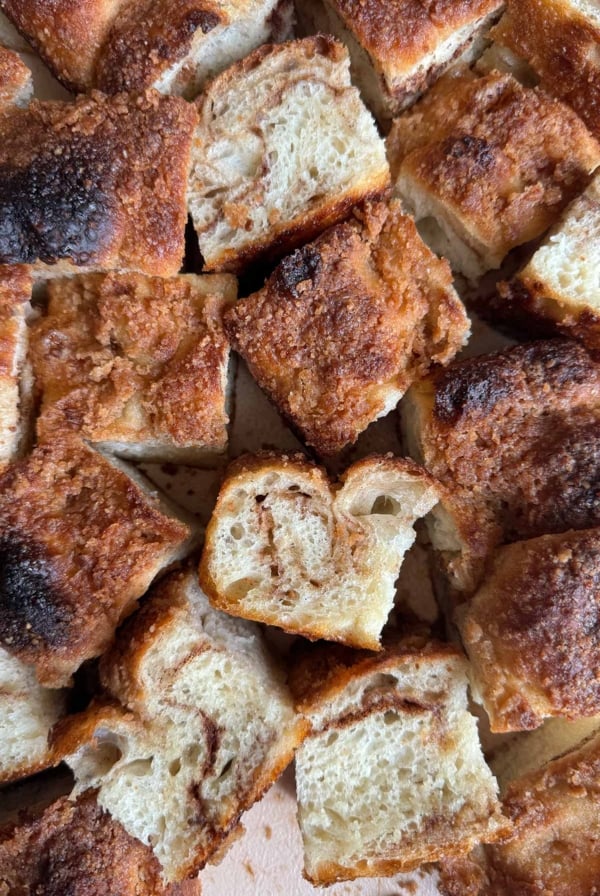
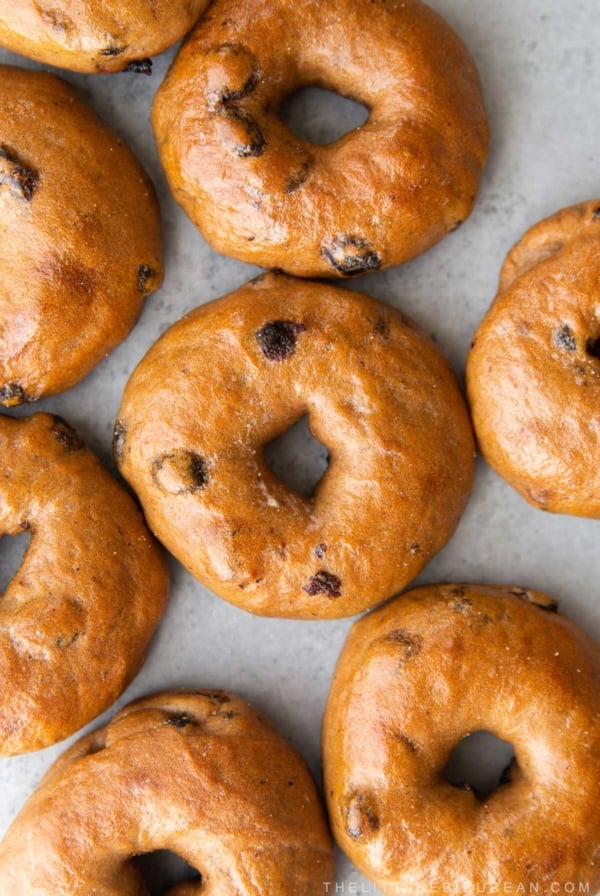
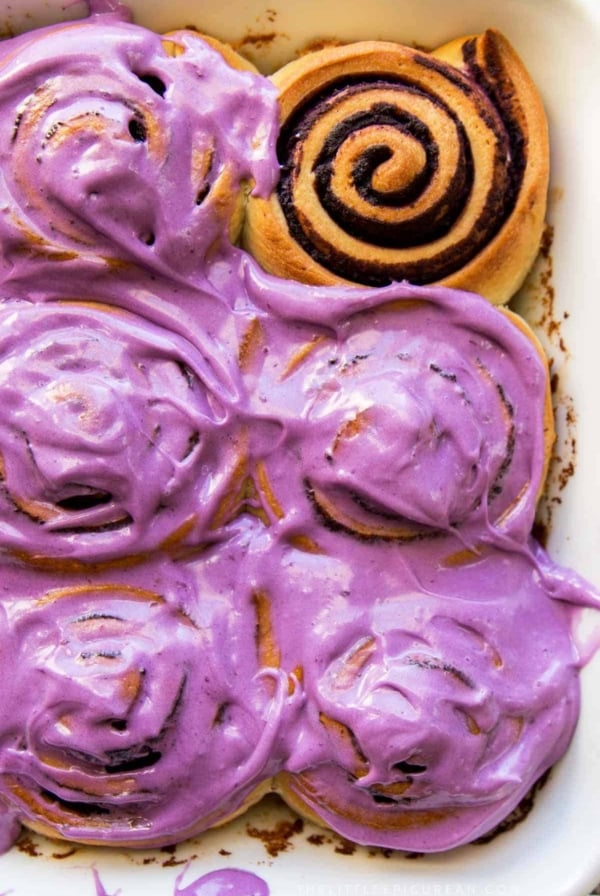
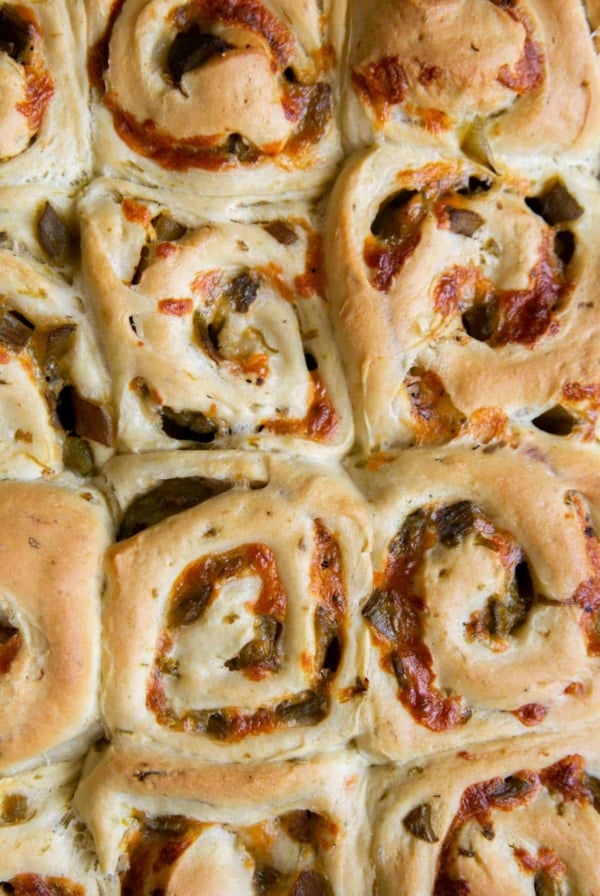





love the pandesal recipe
I made these for dinner. Super easy to make and super delicious. Trying not to eat more is becoming increasingly difficult.
Delicious and very easy to make. Thank you.For sweet bean suppose, what type of sweet filling can I use?
You can use sweetened red bean paste (available in cans or jars), mung bean paste, or black sesame bean paste.
How do you measure for 24 rolls being the same size or close to it? Also I can’t seem to roll them up into a bowl without all kinds of creases on the bottom. Other than that, I think I’ll be OK. I’m waiting for them to come out of the oven. Oh yes, the dough was pretty stiff. Not like other dose. It seemed hard and I had to leave it out for quite some time to get it to rise
1.) Weigh the dough, then divide the total by 24 to determine the weight of each portion.
2.) Did you measure the ingredients by volume or weight? Your dough seems dry, likely due to excess flour from volume measuring. The dough is supposed to be firm but supple. It should feel elastic with a smooth surface.
3.) Is the yeast you used still active? Did it foam when you added it to warm liquid?
Thank you for your recipe.
Can I put the dough balls in the fridge and bake later?
Hi! Can you store it in the freezer? And if yes, for how long? Thank you!
Did she ever reply about refrigeration??
Thank you so much for this recipe! This was my first time making pan de sal and it turned out wonderful! I had some coffee today and dipped a toasted pan de sal in my coffee… it brought me back to those moments when I’d sit with my mom in the morning and drink coffee and eat pan de sal with her. Thank you for sparking those memories up again! <3
Hi!! I don’t have a standing mixer, can I just knead the dough by hand instead? Thanks!
Yes, you can knead the dough by hand. It takes a little longer, but works just as well.
Hi, I started a pandesalan, and I just learned from my former baker. He used to rest the dough over night on our trays, and still, this is the method that we use now, we use a roller to knead them. Recently, I bought a dough kneader to knead it easily. We make 18 to 23 kilos of pandesal a day. But I noticed that our pandesal is too soft or has risen too much even after it is sold and densed when baked.I tried to reduce the kneading time to 7 minutes, but it’s still the same. What will I do? We start baking 4 in the afternoon and the store opens at 4am the following day.
Correction: it has risen too much before they are sold